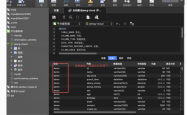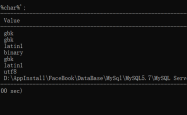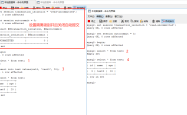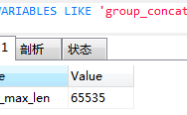MySQL 8中新增的这三大索引 隐藏、降序、函数
MySQL 8中的隐藏、降序、函数索引
一、隐藏索引
1.隐藏索引概述
- MySQL 8.0开始支持隐藏索引(invisible index),不可见索引。
- 隐藏索引不会被优化器使用,但仍然需要进行维护。
- 应用场景:软删除、灰度发布。
在之前MySQL的版本中,只能通过显式的方式删除索引,如果删除后发现索引删错了,又只能通过创建索引的方式将删除的索引添加回来,如果数据库中的数据量非常大,或者表比较大,这种操作的成本非常高。
在MySQL 8.0中,只需要将这个索引先设置为隐藏索引,使查询优化器不再使用这个索引,但是,此时这个索引还是需要MySQL后台进行维护,当确认将这个索引设置为隐藏索引系统不会受到影响时,再将索引彻底删除。这就是软删除功能。
灰度发布,就是说创建索引时,首先将索引设置为隐藏索引,通过修改查询优化器的开关,使隐藏索引对查询优化器可见,通过explain对索引进行测试,确认这个索引有效,某些查询可以使用到这个索引,就可以将其设置为可见索引,完成灰度发布的效果。
2.隐藏索引操作
(1)登录MySQL,创建testdb数据库,并在数据库中创建一张测试表t1
?| 1 2 3 4 5 6 | mysql> create database if not exists testdb; Query OK, 1 row affected (0.58 sec) mysql> use testdb; Database changed mysql> create table if not exists t1(i int , j int ); Query OK, 0 rows affected (0.05 sec) |
(2)在字段i上创建索引,如下所示。
?| 1 2 3 | mysql> create index i_idx on t1(i); Query OK, 0 rows affected (0.34 sec) Records: 0 Duplicates: 0 Warnings: 0 |
(3)在字段j上创建隐藏索引,创建隐藏索引时,只需要在创建索引的语句后面加上invisible关键字,如下所示
?| 1 2 3 | mysql> create index j_idx on t1(j) invisible; Query OK, 0 rows affected (0.01 sec) Records: 0 Duplicates: 0 Warnings: 0 |
(4)查看t1表中的索引情况,如下所示
?| 1 2 3 4 5 6 7 8 9 10 11 12 13 14 15 16 17 18 19 20 21 22 23 24 25 26 27 28 29 30 31 32 33 34 | mysql> show index from t1 \G *************************** 1. row *************************** Table : t1 Non_unique: 1 Key_name: i_idx Seq_in_index: 1 Column_name: i Collation: A Cardinality: 0 Sub_part: NULL Packed: NULL Null : YES Index_type: BTREE Comment: Index_comment: Visible: YES Expression: NULL *************************** 2. row *************************** Table : t1 Non_unique: 1 Key_name: j_idx Seq_in_index: 1 Column_name: j Collation: A Cardinality: 0 Sub_part: NULL Packed: NULL Null : YES Index_type: BTREE Comment: Index_comment: Visible: NO Expression: NULL 2 rows in set (0.02 sec) |
可以看到t1表中有两个索引,一个是i_idx,一个是j_idx,i_idx的Visible属性为YES,表示这个索引可见; j_idx的Visibles属性为NO,表示这个索引不可见。
(5)查看查询优化器对这两个索引的使用情况。
首先,使用字段i进行查询,如下所示。
?| 1 2 3 4 5 6 7 8 9 10 11 12 13 14 15 | mysql> explain select * from t1 where i = 1 \G *************************** 1. row *************************** id: 1 select_type: SIMPLE table : t1 partitions: NULL type: ref possible_keys: i_idx key : i_idx key_len: 5 ref: const rows : 1 filtered: 100.00 Extra: NULL 1 row in set , 1 warning (0.02 sec) |
可以看到,查询优化器会使用i字段的索引进行优化。
接下来,使用字段j进行查询,如下所示。
| 1 2 3 4 5 6 7 8 9 10 11 12 13 14 15 | mysql> explain select * from t1 where j = 1 \G *************************** 1. row *************************** id: 1 select_type: SIMPLE table : t1 partitions: NULL type: ALL possible_keys: NULL key : NULL key_len: NULL ref: NULL rows : 1 filtered: 100.00 Extra: Using where 1 row in set , 1 warning (0.00 sec) |
可以看到,查询优化器并没有使用j字段上的隐藏索引,会使用全表扫描的方式查询数据。
(6)使隐藏索引对优化器可见
在MySQL 8.x 中提供了一种新的测试方式,可以通过优化器的一个开关来打开某个设置,使隐藏索引对查询优化器可见。
查看查询优化器的开关,如下所示。
| 1 2 3 4 | mysql> select @@optimizer_switch \G *************************** 1. row *************************** @@optimizer_switch: index_merge= on ,index_merge_union= on ,index_merge_sort_union= on ,index_merge_intersection= on ,engine_condition_pushdown= on ,index_condition_pushdown= on ,mrr= on ,mrr_cost_based= on ,block_nested_loop= on ,batched_key_access= off ,materialization= on ,semijoin= on ,loosescan= on ,firstmatch= on ,duplicateweedout= on ,subquery_materialization_cost_based= on ,use_index_extensions= on ,condition_fanout_filter= on ,derived_merge= on ,use_invisible_indexes= off ,skip_scan= on ,hash_join= on 1 row in set (0.00 sec) |
这里,可以看到如下一个属性值:
?| 1 | use_invisible_indexes= off |
表示优化器是否使用不可见索引,默认为off不使用。
接下来,在MySQL的会话级别使查询优化器使用不可见索引,如下所示。
| 1 2 | mysql> set session optimizer_switch= "use_invisible_indexes=on" ; Query OK, 0 rows affected (0.00 sec) |
接下来,再次查看查询优化器的开关设置,如下所示
?| 1 2 3 4 | mysql> select @@optimizer_switch \G *************************** 1. row *************************** @@optimizer_switch: index_merge= on ,index_merge_union= on ,index_merge_sort_union= on ,index_merge_intersection= on ,engine_condition_pushdown= on ,index_condition_pushdown= on ,mrr= on ,mrr_cost_based= on ,block_nested_loop= on ,batched_key_access= off ,materialization= on ,semijoin= on ,loosescan= on ,firstmatch= on ,duplicateweedout= on ,subquery_materialization_cost_based= on ,use_index_extensions= on ,condition_fanout_filter= on ,derived_merge= on ,use_invisible_indexes= on ,skip_scan= on ,hash_join= on 1 row in set (0.00 sec) |
此时,可以看到use_invisible_indexes=on,说明隐藏索引对查询优化器可见了。
再次分析使用t1表的j字段查询数据,如下所示。
?| 1 2 3 4 5 6 7 8 9 10 11 12 13 14 15 | mysql> explain select * from t1 where j = 1 \G *************************** 1. row *************************** id: 1 select_type: SIMPLE table : t1 partitions: NULL type: ref possible_keys: j_idx key : j_idx key_len: 5 ref: const rows : 1 filtered: 100.00 Extra: NULL 1 row in set , 1 warning (0.00 sec) |
可以看到,此时查询优化器使用j字段上的隐藏索引来优化查询了。
(7)设置索引的可见与不可见
将字段j上的隐藏索引设置为可见,如下所示。
?| 1 2 3 | mysql> alter table t1 alter index j_idx visible; Query OK, 0 rows affected (0.01 sec) Records: 0 Duplicates: 0 Warnings: 0 |
将字段j上的索引设置为不可见,如下所示。
?| 1 2 3 | mysql> alter table t1 alter index j_idx invisible; Query OK, 0 rows affected (0.01 sec) Records: 0 Duplicates: 0 Warnings: 0 |
(8)MySQL中主键不能设置为不可见索引
值得注意的是:在MySQL中,主键是不可以设置为不可见的。
在testdb数据库中创建一张测试表t2,如下所示。
| 1 2 | mysql> create table t2(i int not null ); Query OK, 0 rows affected (0.01 sec) |
接下来,在t2表中创建一个不可见主键,如下所示
?| 1 2 | mysql> alter table t2 add primary key pk_t2(i) invisible; ERROR 3522 (HY000): A primary key index cannot be invisible |
可以看到,此时SQL语句报错,主键不能被设置为不可见索引。
二、降序索引
1.降序索引概述
- MySQL 8.0开始真正支持降序索引(descending index)。
- 只有InnoDB存储引擎支持降序索引,只支持BTREE降序索引。
- MySQL 8.0不再对GROUP BY操作进行隐式排序
2.降序索引操作
(1)MySQL 5.7中支持的语法
首先,在MySQL 5.7中创建测试数据库testdb,在数据库testdb中创建测试表t2,如下所示。
?| 1 2 3 4 5 6 | mysql> create database if not exists testdb; Query OK, 0 rows affected (0.71 sec) mysql> use testdb; Database changed mysql> create table if not exists t2(c1 int , c2 int , index idx1(c1 asc , c2 desc )); Query OK, 0 rows affected (0.71 sec) |
其中,在t2表中创建了名为idx1的索引,索引中c1字段升序排序,c2字段降序排序。
接下来,查看t2表的创建信息,如下所示
?| 1 2 3 4 5 6 7 8 9 | mysql> show create table t2 \G *************************** 1. row *************************** Table : t2 Create Table : CREATE TABLE `t2` ( `c1` int (11) DEFAULT NULL , `c2` int (11) DEFAULT NULL , KEY `idx1` (`c1`,`c2`) ) ENGINE=InnoDB DEFAULT CHARSET=utf8mb4 1 row in set (0.16 sec) |
可以看到,MySQL 5.7版本在创建表的信息中,没有字段c1和c2的排序信息,默认都是升序。
(2)MySQL 8.0中支持的语法
在MySQL 8.x中同样创建t2表,如下所示
?| 1 2 | mysql> create table if not exists t2(c1 int , c2 int , index idx1(c1 asc , c2 desc )); Query OK, 0 rows affected, 1 warning (0.00 sec) |
接下来,查看t2表的创建信息,如下所示
?| 1 2 3 4 5 6 7 8 9 | mysql> show create table t2 \G *************************** 1. row *************************** Table : t2 Create Table : CREATE TABLE `t2` ( `c1` int (11) DEFAULT NULL , `c2` int (11) DEFAULT NULL , KEY `idx1` (`c1`,`c2` DESC ) ) ENGINE=InnoDB DEFAULT CHARSET=utf8mb4 COLLATE =utf8mb4_0900_ai_ci 1 row in set (0.00 sec) |
可以看到,在MySQL 8.x中,创建的索引中存在字段的排序信息。
(3)MySQL 5.7中查询优化器对索引的使用情况
首先,在表t2中插入一些数据,如下所示。
?| 1 2 3 | mysql> insert into t2(c1, c2) values (1, 100), (2, 200), (3, 150), (4, 50); Query OK, 4 rows affected (0.19 sec) Records: 4 Duplicates: 0 Warnings: 0 |
接下来,查询t2表中的数据,如下所示。
?| 1 2 3 4 5 6 7 8 9 10 | mysql> select * from t2; + ------+------+ | c1 | c2 | + ------+------+ | 1 | 100 | | 2 | 200 | | 3 | 150 | | 4 | 50 | + ------+------+ 4 rows in set (0.00 sec) |
可以看到,t2表中的数据插入成功。
接下来,查看查询优化器对索引的使用情况,这里,查询语句按照c1字段升序,按照c2字段降序,如下所示。
?| 1 2 3 4 5 6 7 8 9 10 11 12 13 14 15 | mysql> explain select * from t2 order by c1, c2 desc \G *************************** 1. row *************************** id: 1 select_type: SIMPLE table : t2 partitions: NULL type: index possible_keys: NULL key : idx1 key_len: 10 ref: NULL rows : 4 filtered: 100.00 Extra: Using index ; Using filesort 1 row in set , 1 warning (0.12 sec) |
可以看到,在MySQL 5.7中,按照c2字段进行降序排序,并没有使用索引。
(4)MySQL 8.x中查询优化器对降序索引的使用情况。
查看查询优化器对降序索引的使用情况。
首先,在表t2中插入一些数据,如下所示。
| 1 2 3 | mysql> insert into t2(c1, c2) values (1, 100), (2, 200), (3, 150), (4, 50); Query OK, 4 rows affected (0.00 sec) Records: 4 Duplicates: 0 Warnings: 0 |
接下来,查询t2表中的数据,如下所示。
?| 1 2 3 4 5 6 7 8 9 10 | mysql> select * from t2; + ------+------+ | c1 | c2 | + ------+------+ | 1 | 100 | | 2 | 200 | | 3 | 150 | | 4 | 50 | + ------+------+ 4 rows in set (0.00 sec) |
可以看到,t2表中的数据插入成功。
在MySQL中如果创建的是升序索引,则指定查询的时候,只能按照升序索引的方式指定查询,这样才能使用升序索引。
接下来,查看查询优化器对索引的使用情况,这里,查询语句按照c1字段升序,按照c2字段降序,如下所示。
?| 1 2 3 4 5 6 7 8 9 10 11 12 13 14 15 | mysql> explain select * from t2 order by c1, c2 desc \G *************************** 1. row *************************** id: 1 select_type: SIMPLE table : t2 partitions: NULL type: index possible_keys: NULL key : idx1 key_len: 10 ref: NULL rows : 4 filtered: 100.00 Extra: Using index 1 row in set , 1 warning (0.00 sec) |
可以看到,在MySQL 8.x中,按照c2字段进行降序排序,使用了索引。
使用c1字段降序,c2字段升序排序,如下所示。
?| 1 2 3 4 5 6 7 8 9 10 11 12 13 14 15 | mysql> explain select * from t2 order by c1 desc , c2 \G *************************** 1. row *************************** id: 1 select_type: SIMPLE table : t2 partitions: NULL type: index possible_keys: NULL key : idx1 key_len: 10 ref: NULL rows : 4 filtered: 100.00 Extra: Backward index scan; Using index 1 row in set , 1 warning (0.00 sec) |
可以看到,在MySQL 8.x中仍然可以使用索引,并使用了索引的反向扫描。
(5)MySQL 8.x中不再对GROUP BY进行隐式排序
在MySQL 5.7中执行如下命令,按照c2字段进行分组,查询每组中数据的记录条数。
?| 1 2 3 4 5 6 7 8 9 10 | mysql> select count (*), c2 from t2 group by c2; + ----------+------+ | count (*) | c2 | + ----------+------+ | 1 | 50 | | 1 | 100 | | 1 | 150 | | 1 | 200 | + ----------+------+ 4 rows in set (0.18 sec) |
可以看到,在MySQL 5.7中,在c2字段上进行了排序操作。
在MySQL 8.x中执行如下命令,按照c2字段进行分组,查询每组中数据的记录条数。
?| 1 2 3 4 5 6 7 8 9 10 | mysql> select count (*), c2 from t2 group by c2; + ----------+------+ | count (*) | c2 | + ----------+------+ | 1 | 100 | | 1 | 200 | | 1 | 150 | | 1 | 50 | + ----------+------+ 4 rows in set (0.00 sec) |
可以看到,在MySQL 8.x中,在c2字段上并没有进行排序操作。
在MySQL 8.x中如果需要对c2字段进行排序,则需要使用order by语句明确指定排序规则,如下所示。
?| 1 2 3 4 5 6 7 8 9 10 | mysql> select count (*), c2 from t2 group by c2 order by c2; + ----------+------+ | count (*) | c2 | + ----------+------+ | 1 | 50 | | 1 | 100 | | 1 | 150 | | 1 | 200 | + ----------+------+ 4 rows in set (0.00 sec) |
三、函数索引
1.函数索引概述
- MySQL 8.0.13开始支持在索引中使用函数(表达式)的值。
- 支持降序索引,支持JSON数据的索引
- 函数索引基于虚拟列功能实现
2.函数索引操作
(1)创建测试表t3
在testdb数据库中创建一张测试表t3,如下所示。
?| 1 2 | mysql> create table if not exists t3(c1 varchar (10), c2 varchar (10)); Query OK, 0 rows affected (0.01 sec) |
(2)创建普通索引
在c1字段上创建普通索引
?| 1 2 3 | mysql> create index idx1 on t3(c1); Query OK, 0 rows affected (0.01 sec) Records: 0 Duplicates: 0 Warnings: 0 |
(3)创建函数索引
在c2字段上创建一个将字段值转化为大写的函数索引,如下所示。
?| 1 2 3 | mysql> create index func_index on t3 (( UPPER (c2))); Query OK, 0 rows affected (0.02 sec) Records: 0 Duplicates: 0 Warnings: 0 |
(4)查看t3表上的索引信息,如下所示。
?| 1 2 3 4 5 6 7 8 9 10 11 12 13 14 15 16 17 18 19 20 21 22 23 24 25 26 27 28 29 30 31 32 33 34 | mysql> show index from t3 \G *************************** 1. row *************************** Table : t3 Non_unique: 1 Key_name: idx1 Seq_in_index: 1 Column_name: c1 Collation: A Cardinality: 0 Sub_part: NULL Packed: NULL Null : YES Index_type: BTREE Comment: Index_comment: Visible: YES Expression: NULL *************************** 2. row *************************** Table : t3 Non_unique: 1 Key_name: func_index Seq_in_index: 1 Column_name: NULL Collation: A Cardinality: 0 Sub_part: NULL Packed: NULL Null : YES Index_type: BTREE Comment: Index_comment: Visible: YES Expression: upper (`c2`) 2 rows in set (0.01 sec) |
(5)查看查询优化器对两个索引的使用情况
首先,查看c1字段的大写值是否等于某个特定的值,如下所示。
?| 1 2 3 4 5 6 7 8 9 10 11 12 13 14 15 | mysql> explain select * from t3 where upper (c1) = 'ABC' \G *************************** 1. row *************************** id: 1 select_type: SIMPLE table : t3 partitions: NULL type: ALL possible_keys: NULL key : NULL key_len: NULL ref: NULL rows : 1 filtered: 100.00 Extra: Using where 1 row in set , 1 warning (0.00 sec) |
可以看到,没有使用索引,进行了全表扫描操作。
接下来,查看c2字段的大写值是否等于某个特定的值,如下所示。
?| 1 2 3 4 5 6 7 8 9 10 11 12 13 14 15 | mysql> explain select * from t3 where upper (c2) = 'ABC' \G *************************** 1. row *************************** id: 1 select_type: SIMPLE table : t3 partitions: NULL type: ref possible_keys: func_index key : func_index key_len: 43 ref: const rows : 1 filtered: 100.00 Extra: NULL 1 row in set , 1 warning (0.00 sec) |
可以看到,使用了函数索引。
(6)函数索引对JSON数据的索引
首先,创建测试表emp,并对JSON数据进行索引,如下所示。
?| 1 2 | mysql> create table if not exists emp(data json, index (( CAST (data->> '$.name' as char (30))))); Query OK, 0 rows affected (0.02 sec) |
上述SQL语句的解释如下:
- JSON数据长度不固定,如果直接对JSON数据进行索引,可能会超出索引长度,通常,会只截取JSON数据的一部分进行索引。
- CAST()类型转换函数,把数据转化为char(30)类型。使用方式为CAST(数据 as 数据类型)。
- data ->> '$.name'表示JSON的运算符
简单的理解为,就是取name节点的值,将其转化为char(30)类型。
接下来,查看emp表中的索引情况,如下所示。
?| 1 2 3 4 5 6 7 8 9 10 11 12 13 14 15 16 17 18 | mysql> show index from emp \G *************************** 1. row *************************** Table : emp Non_unique: 1 Key_name: functional_index Seq_in_index: 1 Column_name: NULL Collation: A Cardinality: 0 Sub_part: NULL Packed: NULL Null : YES Index_type: BTREE Comment: Index_comment: Visible: YES Expression: cast (json_unquote(json_extract(`data`,_utf8mb4\'$. name \')) as char (30) charset utf8mb4) 1 row in set (0.00 sec) |
(7)函数索引基于虚拟列实现
首先,查看t3表的信息,如下所示。
?| 1 2 3 4 5 6 7 8 | mysql> desc t3; + -------+-------------+------+-----+---------+-------+ | Field | Type | Null | Key | Default | Extra | + -------+-------------+------+-----+---------+-------+ | c1 | varchar (10) | YES | MUL | NULL | | | c2 | varchar (10) | YES | | NULL | | + -------+-------------+------+-----+---------+-------+ 2 rows in set (0.00 sec) |
在c1上建立了普通索引,在c2上建立了函数索引。
接下来,在t3表中添加一列c3,模拟c2上的函数索引,如下所示。
?| 1 2 3 | mysql> alter table t3 add column c3 varchar (10) generated always as ( upper (c1)); Query OK, 0 rows affected (0.03 sec) Records: 0 Duplicates: 0 Warnings: 0 |
c3列是一个计算列,c3字段的值总是使用c1字段转化为大写的结果。
接下来,向t3表中插入一条数据,其中,c3列是一个计算列,c3字段的值总是使用c1字段转化为大写的结果,在插入数据的时候,不需要为c3列插入数据,如下所示。
?| 1 2 | mysql> insert into t3(c1, c2) values ( 'abc' , 'def' ); Query OK, 1 row affected (0.00 sec) |
查询t3表中的数据,如下所示。
?| 1 2 3 4 5 6 7 | mysql> select * from t3; + ------+------+------+ | c1 | c2 | c3 | + ------+------+------+ | abc | def | ABC | + ------+------+------+ 1 row in set (0.00 sec) |
可以看到,并不需要向c3列中插入数据,c3列的数据为c1字段的大写结果数据。
如果想模拟函数索引的效果,则可以使用如下方式。
首先,在c3列上添加索引,如下所示。
| 1 2 3 | mysql> create index idx3 on t3(c3); Query OK, 0 rows affected (0.11 sec) Records: 0 Duplicates: 0 Warnings: 0 |
接下来,再次查看c1字段的大写值是否等于某个特定的值,如下所示。
?| 1 2 3 4 5 6 7 8 9 10 11 12 13 14 15 | mysql> explain select * from t3 where upper (c1) = 'ABC' \G *************************** 1. row *************************** id: 1 select_type: SIMPLE table : t3 partitions: NULL type: ref possible_keys: idx3 key : idx3 key_len: 43 ref: const rows : 1 filtered: 100.00 Extra: NULL 1 row in set , 1 warning (0.00 sec) |
此时,就使用了idx3索引。
到此这篇关于MySQL 8中新增的这三大索引 隐藏、降序、函数的文章就介绍到这了,更多相关MySQL 8中的隐藏、降序、函数索引内容请搜索服务器之家以前的文章或继续浏览下面的相关文章希望大家以后多多支持服务器之家!
原文链接:https://blog.csdn.net/l1028386804/article/details/119442194
1.本站遵循行业规范,任何转载的稿件都会明确标注作者和来源;2.本站的原创文章,请转载时务必注明文章作者和来源,不尊重原创的行为我们将追究责任;3.作者投稿可能会经我们编辑修改或补充。











